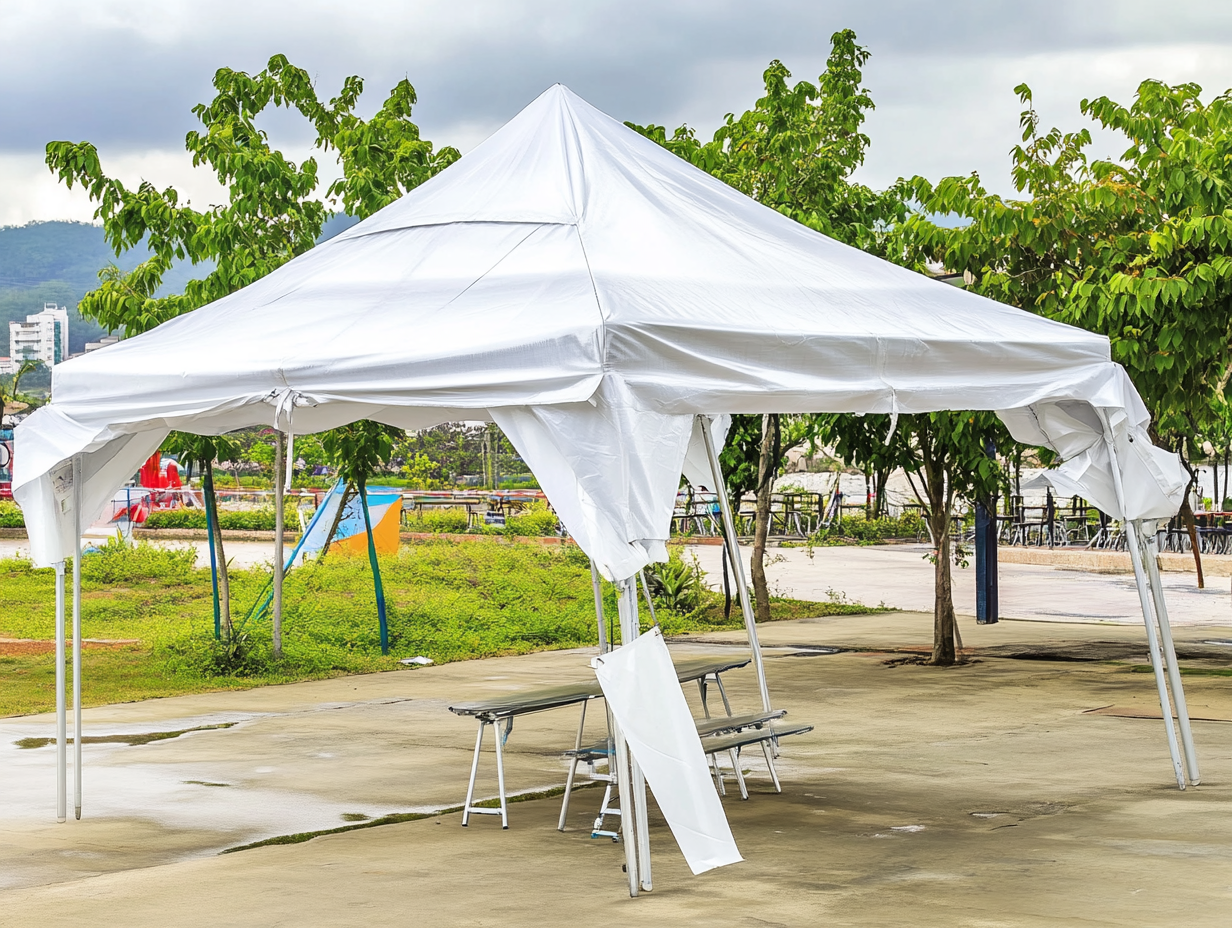There's no one-size-fits-all answer when it comes to a pop-up canopy tent's wind resistance.
Several factors come into play, including frame construction, fabric type and fit, anchoring methods, setup location, and canopy size and shape. Each of these elements plays a role in determining your tent's wind resistance.
In general, a properly secured pop-up canopy tent can handle light to moderate winds up to 20 mph without much fuss. When winds pick up to between 21-30 mph, you'll need to take some extra precautions. Once wind speeds exceed 30 mph, it's time to pack up your tent for safety.
To give you a clearer picture, we'll use the Beaufort Wind Scale to show you how different setups fare in various wind conditions. We'll look at unanchored tents, which are great for a calm day at the beach but not much else; staked tents, which add some stability and are perfect for a breezy afternoon; and weighted-down tents, which are your best bet for windier conditions.
By understanding how these different setups perform, you'll be better equipped to prepare your pop-up canopy tent for whatever Mother Nature throws your way.

Battling the Breeze: What Keeps Your Canopy Upright?
Before we dive into the nitty-gritty of wind resistance, let's unpack the key factors. Your pop-up canopy tent isn't just a simple shelter - it's a complex structure with several elements working together to keep you covered, come rain or shine (or wind!).
So, what exactly determines how well your tent stands up to a gusty challenge?
Let's break it down.
1. Frame Material and Construction

-
Material: Aluminum frames are lightweight but may flex more, while steel frames are heavier and offer better wind resistance.
-
Thickness: Thicker poles (e.g., 40mm) provide greater stability and resistance to bending.
-
Joints: Reinforced or welded joints strengthen the overall structure, reducing weak points.
2. Canopy Fabric
-
Fabric Type: Higher denier fabrics (e.g., 600D polyester) offer superior durability and tear resistance. PVC-coated polyester excels in wind resistance, while lighter materials like nylon or low-denier polyester are more vulnerable, making it important to choose the right canopy fabric for your setup..
-
Fit: A tightly stretched canopy reduces wind stress compared to a loose fit.
3. Anchoring Methods
Just like a stubborn toddler during bedtime, a well-anchored canopy tent refuses to budge no matter how hard the wind tries to move it. Here's how to make your canopy as immovable as that determined child:
-
Stakes: Deep, angled stakes at a 45-degree angle provide strong hold in firm ground. Softer soil may require longer or additional stakes.
-
Canopy Weights: Aim for about 45 lbs per leg to secure your canopy during strong winds. However, if you’re not expecting heavy gusts, lighter options like 20 lb canopy weights per leg can still provide reliable stability for calm-weather events.
-
Guy Lines: These distribute wind forces evenly across the structure. Proper angling and secure attachment points reduce collapse risk.
-
Surface: Anchoring effectiveness varies by surface. Soft ground may need deeper stakes and more weight, while hard surfaces require heavy ballasts or specialized anchors.
4. Setup Location
-
Wind Exposure: Sheltered areas near buildings or trees offer natural wind breaks. Open spaces increase exposure, demanding stronger anchoring.
-
Elevation: Hilltops experience stronger winds due to fewer obstructions. Valleys provide more natural wind protection.
-
Obstructions: Nearby objects can create wind tunnels or eddies, potentially stressing the canopy from unexpected angles.
5. Canopy Size and Shape
-
Size: (e.g., Larger canopies 10x20) present more surface area to wind compared to smaller ones (10x10), increasing vulnerability to tipping, lifting, or shifting.
-
Shape: Peaked canopies allow smoother wind flow, reducing overall resistance.
What Wind Speeds can a Pop-up Canopy Tent Withstand?
There's no standardized wind rating system for canopies in the industry. While some manufacturers may claim certain wind resistance capabilities, these are often marketing gimmicks rather than certified ratings.
To provide a practical assessment, we'll use the Beaufort Wind Scale. This widely recognized system categorizes wind speeds by their observable effects, allowing us to anticipate how a canopy might react in different scenarios, regardless of manufacturer claims.
Let's examine how a 10x10 pop-up canopy tent - one of the most popular choices for outdoor events - performs under various setup scenarios across different wind speeds.
|
Wind Speed (mph) |
Wind Description |
Non-Anchored Canopy |
Anchored Canopy |
Canopy with Weights |
|
0-10 mph |
Calm to Light Breeze |
Stable, minimal movement |
Stable, minimal movement |
Stable, minimal movement |
|
11-15 mph |
Gentle Breeze |
Slight shifting, risk of instability |
May lift slightly at corners, slight swaying if stakes aren't secure |
Stable with minimal risk of shifting or lifting |
|
16-20 mph |
Moderate Breeze |
Significant movement, risk of tipping |
Noticeable swaying, possible lifting at corners, potential lateral shifting on hard surfaces |
Stable, but possible slight lifting or shifting |
|
21-25 mph |
Fresh Breeze |
Extremely unsafe, constant shifting, high risk of tipping |
Considerable swaying, possible lifting at edges, stakes may loosen |
Grounded but significant swaying and movement, frequent checks required |
|
26-30 mph |
Strong Breeze |
Extremely unsafe, high risk of being lifted or blown away |
Significant swaying, possible lifting, stakes may fail |
Struggles to stay grounded, noticeable movement, additional anchoring strongly recommended |
|
31-40 mph |
Gale |
Extremely unsafe, collapse or blow away is a certainty |
Likely to fail even with stakes and guy lines. Dismantle immediately. |
Unsafe, significant risk of collapse, immediate dismantling necessary |
0-10 mph: Calm to Light Breeze
In calm to light breeze conditions, with wind speeds between 0-10 mph, leaves may rustle gently, and you might feel a soft breeze on your face. The impact on a canopy tent is minimal, making it suitable for most outdoor events.
11-15 mph: Gentle Breeze
When wind speeds increase to 11-15 mph, you’ll notice a gentle breeze. Leaves and small twigs move continuously, and light flags start to extend. This is when the wind begins to have a more noticeable effect on a canopy tent.
-
Non-Anchored Canopy: The canopy may shift slightly, especially at the corners or edges, increasing the risk of instability.
-
Anchored Canopy: Wind at this speed can cause the legs to lift slightly at the corners or result in slight swaying, particularly if the stakes aren't secure due to ground conditions.
-
Canopy with Weights: The canopy remains stable in 11-15 mph winds, with minimal risk of shifting or lifting.
16-20 mph: Moderate Breeze
This is when most people consider it "windy" outside. In a moderate breeze with wind speeds between 16-20 mph, small branches may move, and dust or loose paper could be lifted off the ground. This level of wind starts to have a more noticeable effect on a canopy tent's stability.
-
Non-Anchored Canopy: The canopy is likely to experience significant movement, especially at the corners or edges, increasing the risk of tipping or being lifted by strong gusts.
-
Anchored Canopy: Even with anchoring, the canopy may sway noticeably, and the legs might lift slightly at the corners if the stakes aren't secure. On hard surfaces, there may also be lateral shifting as the stakes struggle to hold the structure firmly.
-
Canopy with Weights: The canopy is still stable, but the legs may lift slightly at the corners or shift side to side during stronger gusts.
21-25 mph: Fresh Breeze
In a fresh breeze with wind speeds between 21-25 mph, large branches sway noticeably, and managing umbrellas becomes difficult. This wind speed poses a significant challenge to the stability of a canopy tent.
-
Non-Anchored Canopy: At this wind speed, a non-anchored canopy becomes extremely unsafe. The structure will likely experience constant shifting, and the legs may lift, causing the canopy to slide or tip over. Due to the high risk of collapse, it is strongly advised to take down the canopy to prevent accidents.
-
Anchored Canopy: While stakes provide some stability, the canopy may still sway considerably, and the legs could lift at the edges during stronger gusts. The stakes might loosen, especially in softer ground, increasing the risk of instability. Additional anchoring, such as extra stakes, guy lines, or weights, is strongly recommended to prevent accidents.
-
Canopy with Weights: The canopy remains grounded, but significant swaying and movement are likely as the wind force increases. The weights alone may not fully counteract the wind’s impact at this speed, so combining them with stakes or additional tie-downs is advisable. Frequent checks are essential to ensure the canopy stays secure, as gusts could cause shifting or lifting, increasing the risk of tipping.
26-30 mph: Strong Breeze
In strong wind conditions with speeds between 26-30 mph, small trees sway, and walking against the wind becomes difficult. This wind level poses serious risks to the stability of a canopy tent.
-
Non-Anchored Canopy: At this wind speed, a non-anchored canopy is extremely unsafe. The structure is almost certain to be lifted, tipped over, or blown away, making it highly dangerous. It is strongly advised to take down the canopy immediately to prevent accidents.
-
Anchored Canopy: Even with stakes, the canopy may experience significant swaying and could lift off the ground at the corners or edges. The stakes may not hold securely, especially if the ground is soft or if the wind direction shifts. Reinforcement with additional weights or tie-downs is crucial, but the risk of instability remains high, making it advisable to take down the canopy.
-
Canopy with Weights: The canopy struggles to stay grounded, with noticeable movement and possible lifting at the corners. Combining weights with stakes and additional anchoring methods is strongly recommended to prevent collapse or severe shifting. Regular monitoring is essential, and taking down the canopy may be necessary if conditions worsen.
31-40 mph: Gale

At 31-40 mph, entire trees are in motion, and walking becomes difficult and hazardous. This wind level is extremely dangerous for any outdoor structure, including canopies.
At this gale level, outdoor event organizers will start shutting down to ensure the safety of attendees, as the risk of canopy tents collapsing or being blown away becomes too great.
Events will typically remain halted until conditions return to a safer level, making immediate dismantling of tents essential to prevent accidents, equipment loss, or injury.
Canopy vs Wind: Lessons from the Field

At its core, understanding canopy wind resistance is about prioritizing safety - for your staff, your customers, and your business. This focus on safety doesn't just prevent disasters; it builds trust and enhances your reputation.
By demonstrating your commitment to a secure environment, you're not only protecting your immediate interests but also investing in long-term customer loyalty and brand credibility.



